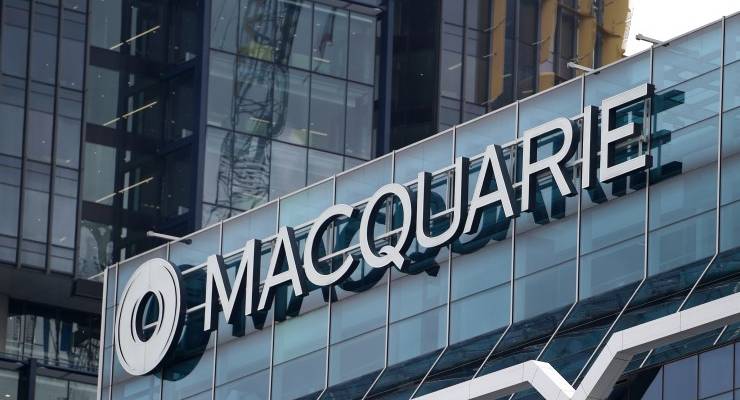
Australia’s fifth biggest bank Macquarie Group released its full year results this morning. After a deluge of reporting over the past two weeks, we’ve now a good sense of how our banking giants are coping with the COVID-19 crisis.
Despite booking credit and equity write-downs of $1.04 billion, Macquarie is in the best shape of them all, delivering a $2.73 billion net profit, just 8% down on the record $2.98 billion it made in 2018-19.
Westpac took the biggest bad-debt hit and probably has the largest restructuring challenge ahead given its business is more complex and diverse than others.
However, never underestimate the damage an over-enthusiastic external new CEO can cause.
NAB’s Ross McEwen is going like a bull at a gate, panicking with a badly structured $3.5 billion capital raising and now pushing the button on an enormously disruptive spill of up to 70 senior management positions.
From a bad-debt point of view, this is what has been revealed in recent days:
- NAB: up from $470 million to $1.161 billion for the half year
- Westpac: up from $461 million to $2.23 billion for the half year
- ANZ: up from $890 million to $1.57 billion for the half year
- Macquarie: up from $144 million in the first half to $661 million in the second half.
That circa $3.5 billion increase is nothing compared to what happened during the GFC when overall big four bad debts soared by about $12 billion compared with the usual cycles.
Stand by for an even bigger round of bad-debt write-offs over the next 12 months, given much of the pain is being delayed by the staggering $160 billion worth of loan repayment deferral requests so far.
From a dividend perspective, APRA chairman Wayne Byres put the frighteners up the banks with an April 7 letter warning that dividends should not be paid unless capital was raised.
NAB consequently launched an emergency $3 billion institutional placement and slashed its interim dividend from 83 cents to 30 cents. ANZ and Westpac both declined to raise capital and deferred any dividend payment for the time being and Macquarie cut its final dividend from $3.60 to $1.80.
Oh for the glory days of just a few weeks ago when CBA paid a $3.54 billion dividend on March 31 after only declaring $649 million in bad debts for the December half year, back in the pre-shutdown world.
Now there’s talk that CBA will book a $3 billion bad-debt hit when it releases a quarterly update next Wednesday.
Macquarie Group was the only bank to release its executive pay details over the past fortnight and they sure don’t call it the Millionaires Factory for nothing.
CEO Shemara Wikramanayake pocketed $18.9 million in 2017-18 and $18.03 million in 2018-19. This latest year to March 30 has delivered a tasty $14.9 million (see all the pay data on page 117 of the annual report).
But in this latest year she was paid less than Martin Stanley, Macquarie’s head of asset management, who received an eye-watering $19.2 million, before tax of course. The only other executive above $10 million was Commodities and Global Markets boss Nick O’Kane who was paid $13.9 million.
You’ve got to hand it to Macquarie. After declaring a record $2.98 billion profit last year, they never walked away from its guidance to the market that the latest result would be “slightly lower”.
Indeed, whilst hundreds of listed companies released updates to the ASX withdrawing earnings guidance, Macquarie was its usual delphic self, saying nothing until the deluge of information this morning.
The oil crash has clearly hurt to a degree because the commodities and global markets division was up 32% to $1.14 billion in the first half, but the second half only delivered $608 million, leaving the full year divisional profit flat at $1.75 billion.
Asset management was the star performer delivering a 16% jump in earnings to a record $2.18 billion.
Macquarie is a very different beast to the other big four banks because it genuinely competes with the other global investment banks in trading, funds management, private equity and corporate advisory — rather than being part of a local banking oligopoly profiting primarily from deposits and home loans.
As the big four progressively exit the wealth management business, Macquarie remains the world’s largest manager of infrastructure assets, with $606 billion in assets under management, down from $563.4 billion six months ago.
As of close of business last night, this is how our big five banks ranked in terms of share market value:
- CBA: $105 billion
- Westpac: $56.3 billion
- NAB: $51.8 billion
- ANZ: $45 billion
- Macquarie: $35.3 billion.
That’s a total of $293.4 billion in value, even after the COVID-19 wipe-out.
Sure, none of our banks compare with the US giants such as JP Morgan Chase which was last night capitalised at $430 billion, but the comparison is better when you look to Europe. Deutsche Bank is only worth $21.6 billion, Swiss powerhouse UBS is capitalised at $57 billion and the pride of Britain, Barclays, has a market cap of only $33 billion, which is even less than Macquarie.
We are all still getting ripped off by our banks, but in a crisis like this it is far better to have strong banks that can absorb billions more in bad-debt write-offs, rather than the situation in Europe where many of the banks never really recovered from the damage caused by the GFC.








After the Hayne RC and now the pandemic, it is not good enough that we express relief that these incompetent and corrupt thieves, the banks, fund managers, insurers and the like may survive the deluge of default to come.
Surely it is time to radically reform corporate law:
– Mandate workforce and community representation on boards of all public corporations.
– Limit the discretion to pay dividends.
– Limit boards fees and executive salaries.
– Mandate that bonuses be held in suspense until the consequences of executive management materialise.
– Mandate that for every dollar of environmental harm caused or financed, $1.50 must be expended on improving the environment. That may even make doing environmental good profitable.
That will get the IPA, the BCA etc apoplectic, which will demonstrate how good such reforms will be for society, the environment and ultimately the economy.